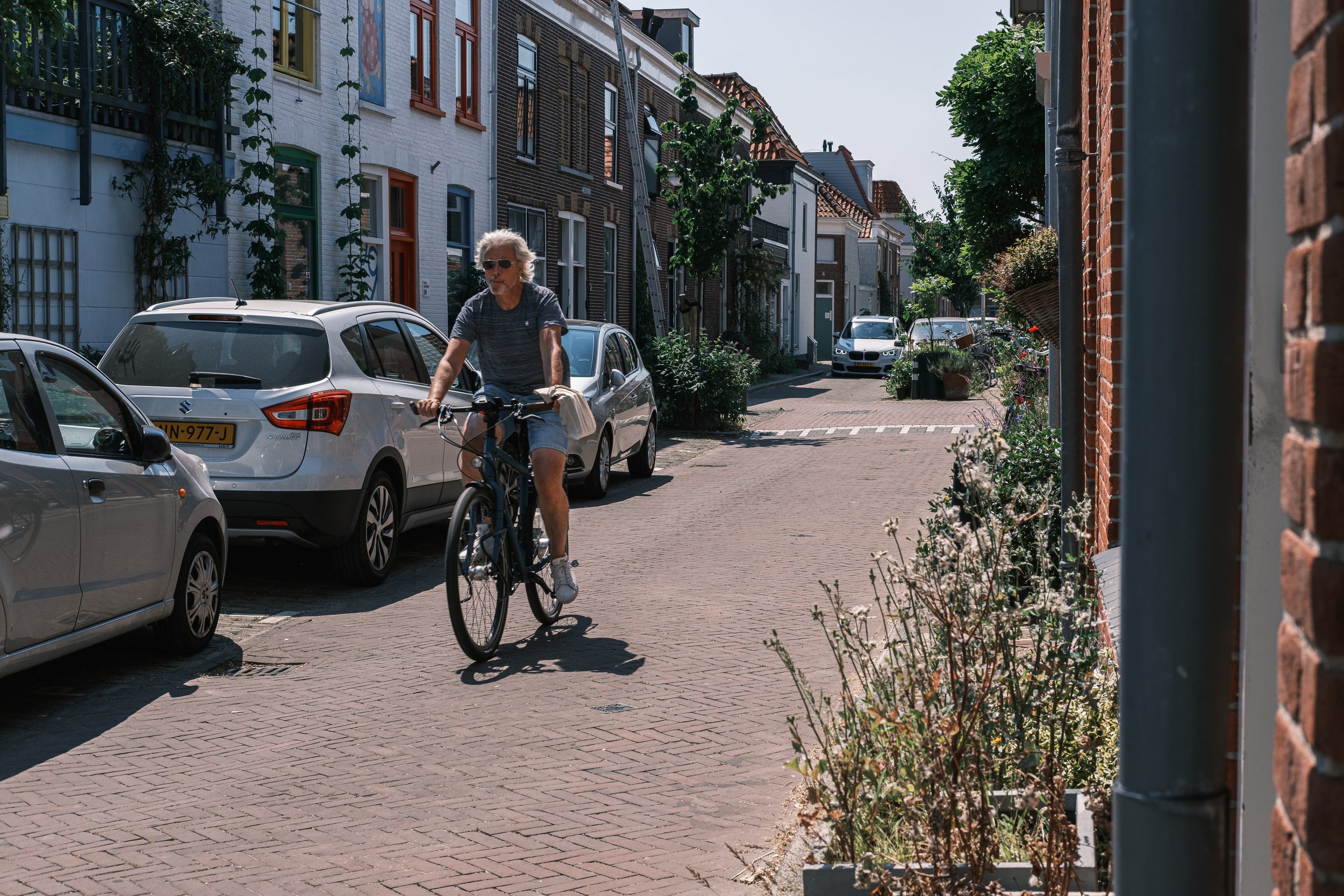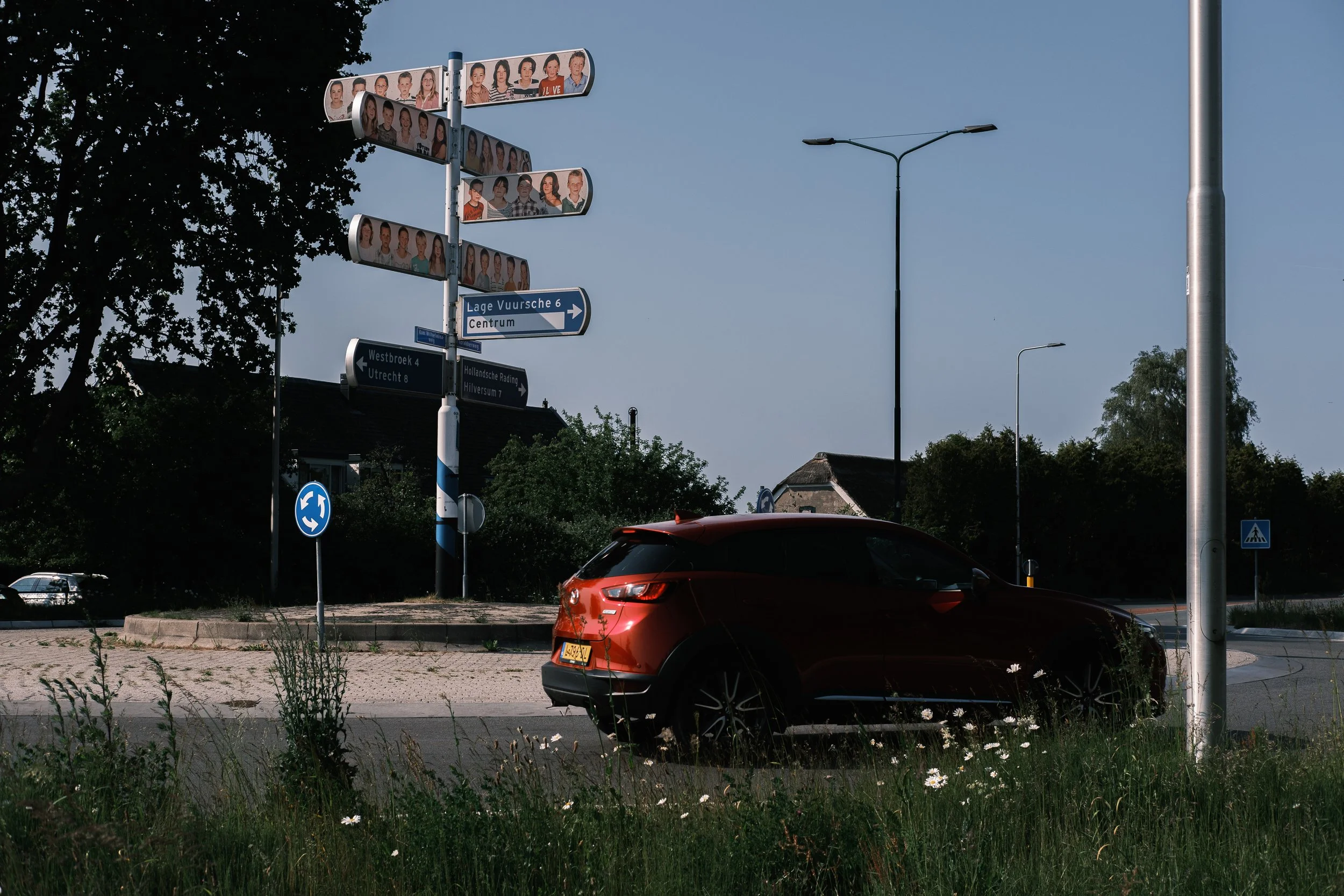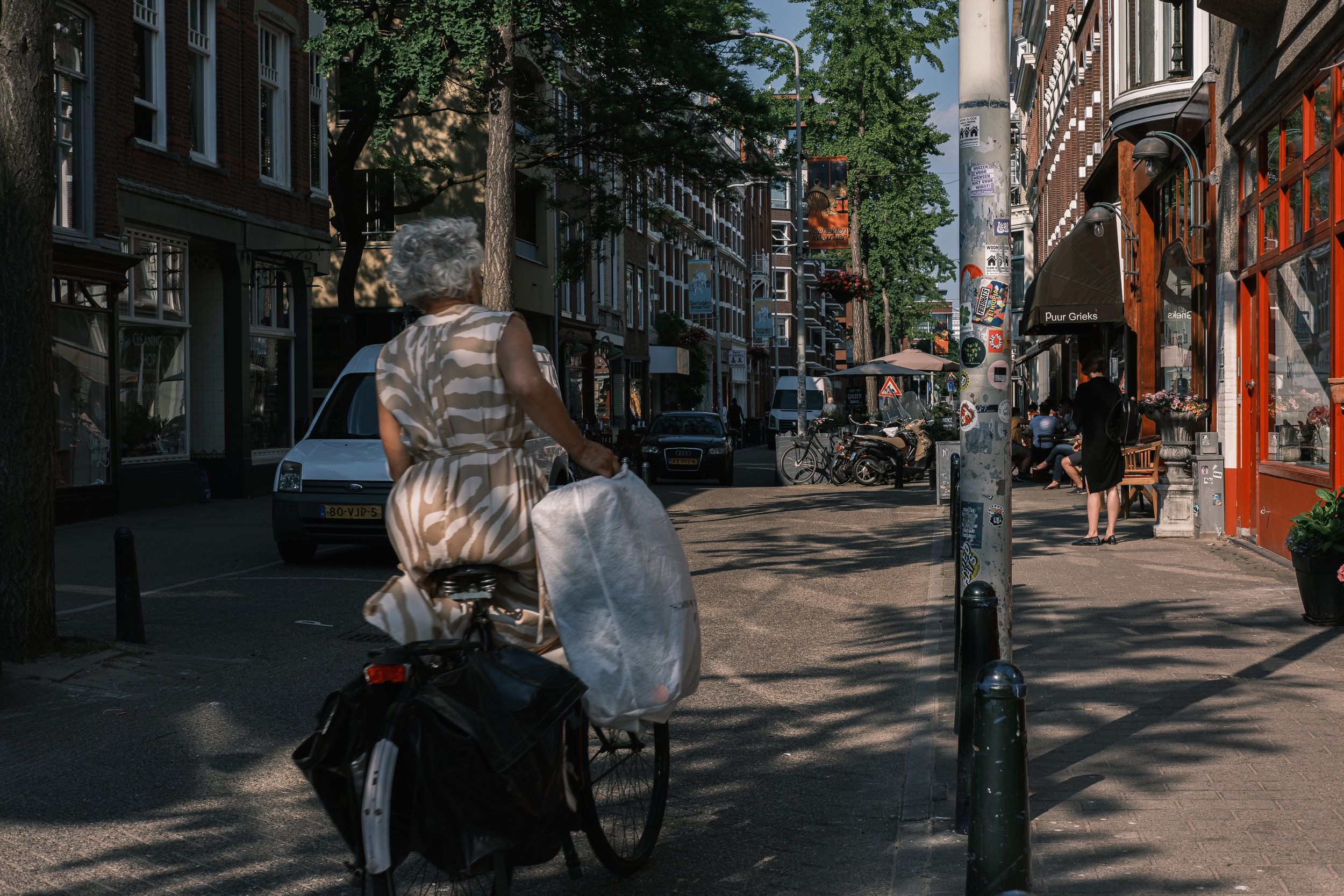Let’s do Real Woonerf’s in North America
To date we’ve been doing them wrong in North America, or at least in the wrong places. Woonerf’s are most often found on residential local streets rather than commercial main streets in the Netherlands.
The photo above is a great example of a Woonerf, narrow, pavers, a lateral shift, a place to sit, lots of vegetation, no curbs, pedestrian scale lighting, and yes, a few parked cars. As I turned and walked further along the street, there was even a dad and his child faithfully recreating the Woonerf sign!
Further along 2e de Riemerstraat, The Hague
I came back from the fietspad trip with the realization that we’re doing Woonerf’s wrong in North America. We tend to use them on commercial main streets, whereas in the Netherlands, they originated on residential streets.
Woonerf’s are such a good idea, I’d argue all residential streets should be Woonerf’s. However, while the Netherlands is best know for them, they are not as common as you might think. I had to make a concerted effort to scour online maps in each city to find them, literally scrolling around online maps looking for slight shifts in the roadway. I did stumble upon a few by chance.
Let’s start with Tuinstraat in Delft, an important stop on this Woonerf tour, inspired by reading the book ‘Curbing Traffic’ by Melissa and Chris Bruntlett, which notes with respect to the birth of the Woonerf “Before Professor Volmuller’s 1970 Traffic Circulation Plan could be fully implemented across Delft, residents of the 50-meter long Tuinstraat were watching in horror as the space outside their front door became increasingly hostile to children, with drivers using it as a shortcut between two adjacent streets. So feeling abandoned by the City staff, they opted to take matters into their own hands; one morning they erected concrete barriers and planted trees at each entry, effectively squatting the area for playing and socializing”.
The Cambridge Dictionary definition suggests a Woonerf is “a road that is designed with special features to reduce the amount of traffic using it, or to make the traffic go slower: Woonerf is Dutch for "living street", and refers to a new way of designing streets to be people-friendly open spaces”. Not that new these days…
The Bruntlett’s go on to state that the Woonerf concept arose from that civil disobedience on Tuinstraat, and while initially fought by the City, the techniques have been accepted and formalized over the years. “Woonerfs consisted of five key features: a clear and distinct entranceway, shared space between cars and pedestrians, physical traffic-calming measures, limited on-street parking, and the incorporation of landscaping and furnishings.” Ok, I guess, then technically Tuinstraat fails the shared space between cars and pedestrians requirement, but as it started the movement, it gets a pass.
As the Tunistraat residents reduced the amount of car traffic entirely, on part of it at least, they were incredibly successful in making their street an extension of their living room. So much so that I even felt a little like I was invading their space taking photos and riding through.
Tuinstraat may be an extremely effective example of reducing vehicle intrusion, but most Woonerf’s do allow motor vehicle traffic. The cross-street with Tunistraat is Westerstraat, a more conventional Woonerf in some respects, but note it also includes curbs that you can see in the background below. There may be key elements, but it appears there’s many ways to build a Woonerf.
Moving now to a suburb of Utrecht, De Bilt which lies to the north. This was one we arrived at by chance heading back from visiting a solar bike path trial project that generates electricity from the bike path. A true multi-use pathway if you like… It felt just like any other with a rough textured surface and no visible solar cells. Pretty neat!
Sorry, before we get back to the woonerf’s, a little north of the solar bike path, signage takes a turn for the weird. If anyone knows the purpose of this sign with children’s faces on it, I’d be keen to know.
Back to the Woonerf’s though, De Bilt is more suburban than Utrecht and as a result, these streets are somewhat closer to those in North American with single-family homes, albeit terraced, with front and rear yards, maybe more like townhomes we’re seeing today. No curbs in this instance, different pavers, the lateral shift with parking switching sides and landscaped planter beds accommodating the shift.
This neighbourhood actually had quite a little network of Woonerf streets. A street perpendicular to that above, did add hi-viz and some directional arrows to aid confused or distracted drivers. This does feature curbs on one side, but none on the other, different paving treatments, planter beds, and parking in a variety of configurations.
Just as we were leaving De Bilt, once more, children recreating the Woonerf sign…
Back in Utrecht, we found a great little Woonerf just around the corner from where we were staying, no curbs, narrow shared space, car parking switching sides via a lateral shift, and some vertical deflection.
This example slightly outside of the historic centre of Utrecht is very similar to the above with no curbs, narrow shared space, car parking switching sides via a lateral shift, personal furniture, i.e., a small bench, for sitting out front of your home.
Cycling, walking, parking your car, all valid uses of this shared space…
A little further along bicycle parking is also present on this Woonerf.
I thought i’d finish up back in The Hague, as this is the one legitimate Woonerf I did find on a commercial street. As you can see here, we have some curbs, but some sections without, clearly defined sidewalks protected by bollards, the lateral shift and car parking, bicycle parking, and a little less vegetation. Still the design makes it very comfortable to wander from side to side.
A little further along the street, the lateral shift is created through patio space and car parking.
I did manage a few shaky iPhone videos of a few of the streets above, and one bonus street I didn’t take any photos of. Take a virtual ride along a few Woonerfs including those in Delft, De Bilt, and Utrecht.
While there may be some key elements of a Woonerf, the presence of a curb doesn’t inherently void a streets Woonerf status. I’d say the most important element is the narrow roadway and lateral shift.
Why would we design residential local streets any other way?
















